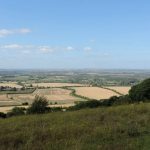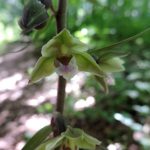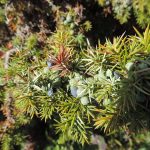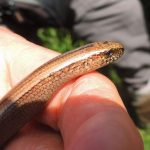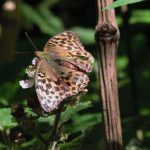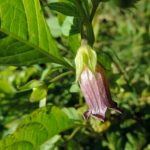On a sunny but very windy afternoon, 21 members gathered at BBOWT’s Chinnor Nature Reserve, Bucks, for a tour organised by Sally Rankin and Alan Parfitt and led by the volunteer warden Mike Turton. Mike has been working here for 40 years, so he was able to show us many interesting natural history features. First, we visited a wood where there was an abundance of Violet Helleborine plants (Epipactis purpurata), now a very rare orchid. A wasp nest under a fallen ash tree had been dug out by badgers and Mike showed us the remarkable structure of the nest.
The wood opened up onto a chalk grassland hillside, which gave us a spectacular view of the area beyond, stretching for tens of miles. In this field many different chalk-loving plants were growing, such as Wild Basil Clinopodium vulgare, Greater Knapweed Centaurea scabiosa, Musk Thistle Carduus nutans, Red Bartsia Odontites vernus, Burnet Saxifrage Pimpinella saxifraga and Wild Parsnip Pastinaca sativa, while a Red Kite Milvus milvus flew over. There were also many flowering plants of Harebell Campanula rotundifolia, Perforate St John’s-wort Hypericum perforatum, Agrimony Agrimonia eupatoria, Lady’s Bedstraw Galium verum and several Juniper bushes (Juniperus communis) with ripening berries. We were invited to each taste one berry, but they were very bitter! It is a problem to establish new plants of Juniper from seed, because the seedlings are readily eaten by wildlife.
Mike carefully lifted a sheet of corrugated iron to see whether any reptiles had congregated here, but none were present. He then showed us three slowworms Anguis fragilis that he had collected earlier. One was bigger and seemed a pregnant female. We were allowed to handle one carefully, making sure that we did not hold them by the tail as they are lizards and can shed them. Later, under another sheet, a slowworm was found that had lost its tail.
All of a sudden we heard a whistle blowing and saw a steam train with four carriages down below, carrying tourists. After the train had disappeared in the distance, we walked further down the hill and saw some more interesting chalk flowers, including Fairy Flax Linum catharticum, Common Rock-rose Helianthemum nummularium, Wild Thyme Thymus polytrichus, Common Centaury Centaurium erythraea, Marjoram Origanum vulgare, Upright Hedge-parsley Torilis japonica, Black Bryony Tamus communis, Dwarf Thistle Cirsium acaule and the rare White Helleborine, Cephalanthera damasonium. There were not as many butterflies as we had hoped for, perhaps because of the high wind, but we did see several specimens of Gatekeeper Pyronia tithonus, Meadow Brown Maniola jartina, Silver-washed Fritillary Argynnis paphia, Essex Skipper Thymelicus lineolus, and the moth Six-spotted Burnet Zygaena filipendulae. Continuing our walk we found Deadly Nightshade Atropa belladonna, Common Spotted-orchid Dactylorhiza fuchsia (in fruit), Small Scabious Scabiosa columbaria and dozens of Autumn Gentian plants, Gentiana amarella (in bud).
After a steep walk down through a wood, we found other chalk-loving plants in the next meadow, such as Clustered Bellflower Campanula glomerata, Field Scabious Knautia arvensis, Yellow-wort Blackstonia perfoliata, Tall Melilot Melilotus altissima, and Pyramidal Orchid Anacamptis pyramidalis (in fruit). Here yellow-rattle is encouraged, to keep the grass down, as it parasitizes on grass roots. However, the field is starting to be invaded by Dogwood Cornus sanguineus, which will cause problems in the future.
A long upward-sloping path through the woods took us back to our starting point. On the way we saw Nettle-leaved Bellflower, Campanula trachelium. When we passed the meadow again, we noticed that the steam train had caused a fire along the trackside. There was a field with stubble left after the harvest that was now very dry and easy to ignite. The fire brigade was called and we later heard that the fire had been extinguished.
Report by Renée Grayer
Pictures by Rob Stallard

